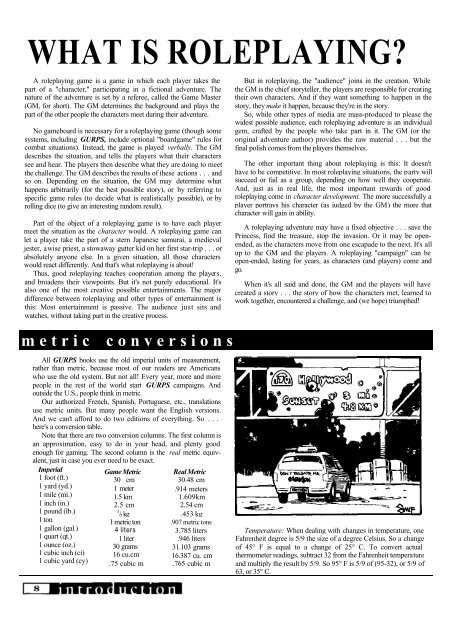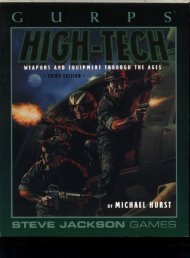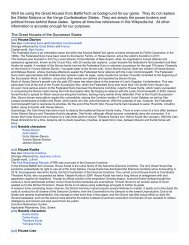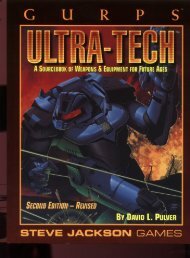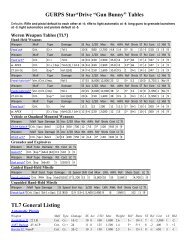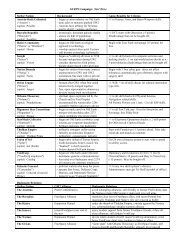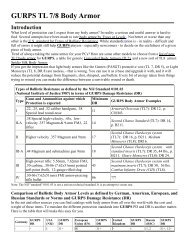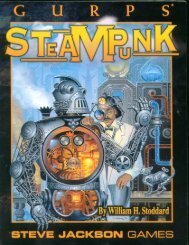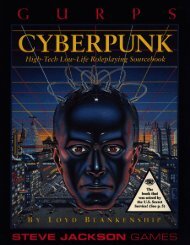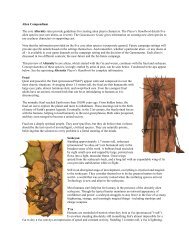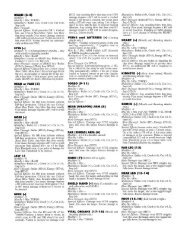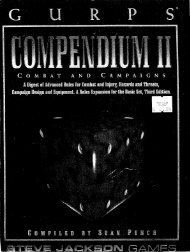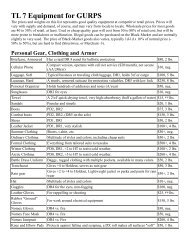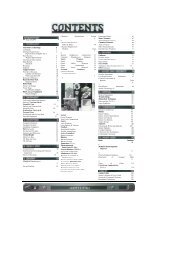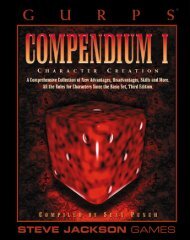MORE FOR <strong>GURPS</strong>This book is all you need to play <strong>GURPS</strong> . . . everything else isoptional. But if you'd like more detail about a particular background,we've got almost everything you could dream of.We've published over 75 different <strong>GURPS</strong> "worldbooks,""sourcebooks" and adventure collections, full of backgrounds, gadgetsand character creation rules for various genres.Fantasy<strong>GURPS</strong> Magic and <strong>GURPS</strong> Grimoire expand on the magic systempresented in this book, with hundreds of new spells and rules forpotions and other new ways to do magic. <strong>GURPS</strong> Fantasydescribes the world of Yrth, where humans torn from our worldinteract with elves, dwarves and dragons. Fantasy II: The MadLands describes a dark, sinister world where hideous monstersroam and the insane gods are beings to be feared rather than worshipped. . . unless you're as crazy as the gods, that is.Other fantasy sourcebooks include <strong>GURPS</strong> Magic Items andMagic Items 2, as well as the <strong>GURPS</strong> Fantasy Bestiary and theaward-winning <strong>GURPS</strong> Fantasy Folk.For fans of Robert E. Howard, we have also published the officialConan game background, with a worldbook and several differentadventures for the mighty barbarian.Science Fiction<strong>GURPS</strong> Ultra -Tech is the sourcebook for science fiction gadgets,from near future to near- magical. <strong>GURPS</strong> Terradynedescribes Man's exploration of the solar system, while <strong>GURPS</strong>Space depicts a far future, with rules for starships and aliens. Othersourcebooks include <strong>GURPS</strong> Aliens, Space Bestiary and Psionics.For a taste of weird science, we have Atomic Horror, a sourcebookfor roleplaying the B-movies of the 1950s.We've also published several worldbooks for backgroundsdrawn from best-selling science fiction, including David Brin'saward-winning Uplift saga.Cyberpunk and Superheroes<strong>GURPS</strong> Cyberpunk gives gritty rules for bionics, computerhacking and survival in a too-near future. Get more high-tech lowlifebackground in Cyberworld and Cyberpunk Adventures.And, of course, <strong>GURPS</strong> Supers has all the rules for buildingsuper-characters. We've released two different super-world backgrounds:International Super Teams and the official Wild Cardsgame book. Both super-worlds are supported by books of charactersand adventures.Time Travel and Historical<strong>GURPS</strong> Time Travel is designed to support either a parallelworldscampaign or actual adventures through history. <strong>GURPS</strong>Timeline presents all of human history in an easy-to-use form, withlots of adventure seeds and campaign ideas.Historical worldbooks can be used as part of a Time Travelcampaign or on their own. Our background books include <strong>GURPS</strong>Arabian Nights, Aztecs, Camelot, China, Cliffhangers, ImperialRome, Middle Ages I, Old West, Robin Hood, Scarlet Pimperneland Vikings. And any campaign, historical or not, can use the deadlyskills of Martial Arts, the vehicles of Vehicles, the weapons ofHigh-Tech (from black powder to bazookas) and the creatures ofthe <strong>GURPS</strong> Bestiary.Modern Day: Horror, Spiesand Strangeness<strong>GURPS</strong> Illuminati describes the world as it might be today ifevery conspiracy theory and tabloid story were true. <strong>GURPS</strong>Horror and Creatures of the Night bring your worst nightmares tolife. Special Ops is modern military adventure, with counter-terroristmissions, hostage rescues and behind-the-lines action. And<strong>GURPS</strong> Espionage deals with the shadowy world of spies, bothreal and cinematic! Our licensed worldbook for The Prisoner alsofalls into the "weird science" category . . .And More . . .The system is still growing. Lots of other material, includingadventures, character books and maps, is available . . . and there'smore every month! We'll send you a free catalog if you write usand send a long self-addressed stamped envelope (SASE). Otherways to keep in touch with us include . . .Pyramid MagazineP\ramid is our bimonthly magazine. Although it is dedicated tocovering the best in gaming from all sources, every issue includessome material for <strong>GURPS</strong> - adventures, backgrounds, designer'snotes and more. You can get a free copy of Pyramid by returningthe questionnaire that came with this book. And you can findPyramid on the World Wide Web at http://www.io.com/sjgames/pyramid/.Illuminati OnlineDo you have a modem? Get one! Illuminati Online supports SJGames with discussion areas for many games, including <strong>GURPS</strong>.Here's where we do a lot of our playtesting! It's up 24 hours perday at 512-448-8950. at up to 28.8k baud (28.8 users should dialdirectly to 512-448-8988) - or telnet to io.com. Give us a call! Visit uson the World Wide Web at http://www.io.com/sjgames/. We alsohave conferences on CompuServe. GEnie and America Online.ConventionsWe also support game conventions. If you're running a convention, orif you'd like to be a <strong>GURPS</strong> GM at a convention, drop us a fine. Weprovide support material and prizes for convention tournaments.Comments, Questions and ErrataWe do everything we can to support the <strong>GURPS</strong> system andhelp its players. Feel free to write us, or talk to us at conventions.We value your comments; we'll take them into account on futurereleases, and even possible revisions of the <strong>Basic</strong> <strong>Set</strong>.We'll do our best to answer any questions you have about thegame, as long as they are accompanied by a stamped, selfaddressedenvelope. Please phrase questions so they can beanswered simply. Write us at Box 18957. Austin. TX 78760. Weget a lot of questions, though, so expect to wait 1-3 months for areply, or more if you ask questions about more than one genre.And, like everybody, we make mistakes . . . but when we goof, weadmit it and do our best to fix it. We'll send you a free errata sheet forany SJ Games product you request, if you send us an SASE. (Pleasespecify - don't just request "all products.")We also have all our errata listed on our web site. Check outhttp://www.io.com/sjgames/errata/.
WHAT IS ROLEPLAYING?A roleplaying game is a game in which each player takes thepart of a "character," participating in a fictional adventure. Thenature of the adventure is set by a referee, called the Game Master(GM, for short). The GM determines the background and plays thepart of the other people the characters meet during their adventure.No gameboard is necessary for a roleplaying game (though somesystems, including <strong>GURPS</strong>, include optional "boardgame" rules forcombat situations). Instead, the game is played verbally. The GMdescribes the situation, and tells the players what their characterssee and hear. The players then describe what they are doing to meetthe challenge. The GM describes the results of these actions . . . andso on. Depending on the situation, the GM may determine whathappens arbitrarily (for the best possible story), or by referring tospecific game rules (to decide what is realistically possible), or byrolling dice (to give an interesting random result).Part of the object of a roleplaying game is to have each playermeet the situation as the character would. A roleplaying game canlet a player take the part of a stern Japanese samurai, a medievaljester, a wise priest, a stowaway gutter kid on her first star-trip . . . orabsolutely anyone else. In a given situation, all those characterswould react differently. And that's what roleplaying is about!Thus, good roleplaying teaches cooperation among the players,and broadens their viewpoints. But it's not purely educational. It'salso one of the most creative possible entertainments. The majordifference between roleplaying and other types of entertainment isthis: Most entertainment is passive. The audience just sits andwatches, without taking part in the creative process.But in roleplaying, the "audience" joins in the creation. Whilethe GM is the chief storyteller, the players are responsible for creatingtheir own characters. And if they want something to happen in thestory, they make it happen, because they're in the story.So, while other types of media are mass-produced to please thewidest possible audience, each roleplaying adventure is an individualgem, crafted by the people who take part in it. The GM (or theoriginal adventure author) provides the raw material . . . but thefinal polish comes from the players themselves.The other important thing about roleplaying is this: It doesn'thave to be competitive. In most roleplaying situations, the party willsucceed or fail as a group, depending on how well they cooperate.And, just as in real life, the most important rewards of goodroleplaying come in character development. The more successfully aplayer portrays his character (as judged by the GM) the more thatcharacter will gain in ability.A roleplaying adventure may have a fixed objective . . . save thePrincess, find the treasure, stop the invasion. Or it may be openended,as the characters move from one escapade to the next. It's allup to the GM and the players. A roleplaying "campaign" can beopen-ended, lasting for years, as characters (and players) come andgo.When it's all said and done, the GM and the players will havecreated a story . . . the story of how the characters met, learned towork together, encountered a challenge, and (we hope) triumphed!metric conversionsAll <strong>GURPS</strong> books use the old imperial units of measurement,rather than metric, because most of our readers are Americanswho use the old system. But not all! Every year, more and morepeople in the rest of the world start <strong>GURPS</strong> campaigns. Andoutside the U.S., people think in metric.Our authorized French, Spanish, Portuguese, etc., translationsuse metric units. But many people want the English versions.And we can't afford to do two editions of everything. So ...here's a conversion table.Note that there are two conversion columns. The first column isan approximation, easy to do in your head, and plenty goodenough for gaming. The second column is the real metric equivalent,just in case you ever need to be exact.Imperial1 foot (ft.)1 yard (yd.)1 mile (mi.)1 inch (in.)1 pound (lb.)1 ton1 gallon (gal.)1 quart (qt.)1 ounce (oz.)1 cubic inch (ci)1 cubic yard (cy)Game Metric30 cm1 meter1.5 km2.5 cm1 / 2 kg1 metric ton4 liters1 liter30 grams16 cu.cm.75 cubic mReal Metric30.48 cm.914 meters1.609km2.54 cm.453 kg.907 metric tons3.785 liters.946 liters31.103 grams16.387 cu. cm.765 cubic mTemperature: When dealing with changes in temperature, oneFahrenheit degree is 5/9 the size of a degree Celsius. So a changeof 45° F is equal to a change of 25° C. To convert actualthermometer readings, subtract 32 from the Fahrenheit temperatureand multiply the result by 5/9. So 95° F is 5/9 of (95-32), or 5/9 of63, or 35° C.
- Page 3 and 4: 17. FLIGHT.........................
- Page 5: Materials Needed for PlayThe GURPS
- Page 9 and 10: Character TypesThere are no "charac
- Page 12 and 13: Four numbers called "attributes" ar
- Page 14 and 15: You are free to set the physical ap
- Page 16 and 17: REPUTATIONSome characters are so we
- Page 18 and 19: These are character traits that are
- Page 20 and 21: Legal Enforcement Powers 5, 10 or 1
- Page 22 and 23: Rapid Healing5 pointsThis advantage
- Page 24 and 25: A minor deity as Patron to a travel
- Page 26 and 27: ReputationVariable (see p. 17)Socia
- Page 28 and 29: Lame-15,-25, or -35 pointsYou have
- Page 30 and 31: Bad Temper-10 pointsYou are not in
- Page 32 and 33: Dyslexia-5 or -15 pointsYou have a
- Page 34 and 35: Pacifism-15 or -30 pointsYou are op
- Page 36 and 37: Shyness-5,-10,-15 pointsYou are unc
- Page 38 and 39: You have a significant responsibili
- Page 40 and 41: A "quirk" is a minor personality tr
- Page 42 and 43: SpecializingRequired Specialization
- Page 44 and 45: MEANING OF SKILL LEVELSSo you have
- Page 46 and 47: Teamster (Mental/Average)Defaults t
- Page 48 and 49: Skiing (Physical/Hard)Defaults to D
- Page 50 and 51: Guns/TL (Physical/Easy)Defaults to
- Page 52 and 53: Any of these skills can be self-tau
- Page 54 and 55: Levels of Language SkillThis table
- Page 56 and 57:
Most outdoor skills can be learned
- Page 58 and 59:
PSIONIC SKILLSThese are special men
- Page 60 and 61:
Forensics/TL (Mental/Hard)Defaults
- Page 62 and 63:
Few Hundred Acres: Knowledge of far
- Page 64 and 65:
Many skills in this category are ta
- Page 66 and 67:
Lockpicking/TL (Mental/Average) Def
- Page 68 and 69:
Gunner/TL See Combat Skills, p. 50M
- Page 70 and 71:
Now you need to decide what equipme
- Page 72 and 73:
Each suit of "real" armor includes
- Page 74 and 75:
Listing Weapons On Your Character S
- Page 76 and 77:
Recording Encumbrance on YourCharac
- Page 78 and 79:
Passive Defense. The first blank is
- Page 80 and 81:
The longer (and the more skillfully
- Page 82 and 83:
When you improve a skill, the cost
- Page 84 and 85:
Not all the advantages and disadvan
- Page 86 and 87:
But remember . . . some skills have
- Page 88 and 89:
ClimbingTo climb anything more diff
- Page 90 and 91:
SwimmingThe Swimming skill (p. 49)
- Page 92 and 93:
WILL ROLLSWhen a character is faced
- Page 94 and 95:
The GURPS combat system is designed
- Page 96 and 97:
WaitDo nothing unless a foe comes w
- Page 98 and 99:
You may only block one attack per t
- Page 100 and 101:
Missile WeaponsMissile weapons are
- Page 102 and 103:
At the end of your move, if you hav
- Page 104 and 105:
The rules for attacking a foe are e
- Page 106 and 107:
tell you how long it will take. In
- Page 108 and 109:
You may normally parry only one att
- Page 110 and 111:
CLOSE COMBATUsing the Move, Step an
- Page 112 and 113:
(adjusted) ST! Note that a shield h
- Page 114 and 115:
Ranged Weapon StatsFor each ranged
- Page 116 and 117:
second. On the table, this rounds u
- Page 118 and 119:
If you are using the "hit location"
- Page 120 and 121:
Removing or folding the stock of a
- Page 122 and 123:
After the initial "freeze" ends, ea
- Page 124 and 125:
ATTACKING INANIMATE OBJECTSThere ar
- Page 126 and 127:
This subtraction will mostoften aff
- Page 128 and 129:
Psionic healing (p. 175) and magica
- Page 130 and 131:
DrowningSee the rules for Swimming,
- Page 132 and 133:
protects completely. Toughness prot
- Page 134 and 135:
Resolving mounted or vehicular comb
- Page 136 and 137:
Using Ranged Weapons From Horseback
- Page 138 and 139:
This section covers special rules f
- Page 140 and 141:
HT: Health and Hit PointsFor a roug
- Page 142 and 143:
Swarm AttacksA group of small creat
- Page 144 and 145:
Encumbrance and MovementEncumbrance
- Page 146 and 147:
A critical miss means the energy co
- Page 148 and 149:
oll will not end the spell, but the
- Page 150 and 151:
If the subject makes the resistance
- Page 152 and 153:
won't work. If anyone but the caste
- Page 154 and 155:
ANIMAL SPELLSThese are the spells r
- Page 156 and 157:
If the summoning spell is repeated,
- Page 158 and 159:
Cost: 1 for an object up to the siz
- Page 160 and 161:
Armor EnchantmentsThese spells work
- Page 162 and 163:
AuraInformationShows the caster a g
- Page 164 and 165:
Psionics, or "psi" abilities, are p
- Page 167 and 168:
GlossaryESP - Extra-Sensory Percept
- Page 169 and 170:
Psionics and MagicMagic and psionic
- Page 171 and 172:
PSYCHOKINESISThis power covers movi
- Page 173 and 174:
Pside EffectsPsi skills can have "s
- Page 175 and 176:
Limitations(Continued)Fickle: varia
- Page 177 and 178:
Player-Made MapsWhenever the player
- Page 179 and 180:
Predetermined ReactionsCertain NPCs
- Page 181 and 182:
Dealing with the PlayersArgumentsAs
- Page 183 and 184:
Time Use SheetsThe Time Use Sheet (
- Page 185 and 186:
Weapons and Armor0. Fists and stone
- Page 187 and 188:
Weather(Continued)WindWinds from ga
- Page 189 and 190:
Gold and SilverA traditional assump
- Page 191 and 192:
JobsThe jobs available in each game
- Page 193 and 194:
Job (Prerequisites), Monthly Income
- Page 195 and 196:
Sooner or later, every GM wants to
- Page 197 and 198:
Features of a GoodAdventureA good a
- Page 199 and 200:
World-BuildingA game world is a com
- Page 201 and 202:
CRITICAL HIT TABLEAll doublings or
- Page 203 and 204:
When the players meet an NPC whose
- Page 205 and 206:
Weapons are listed in groups, accor
- Page 207 and 208:
MODERN AND ULTRA-TECH WEAPONSWeapon
- Page 209 and 210:
ANCIENT/MEDIEVAL ARMORUse this tabl
- Page 211 and 212:
FANTASY/MEDIEVAL EQUIPMENTThe follo
- Page 231 and 232:
After eight printings of the GURPS
- Page 233 and 234:
of Divination should match the "fla
- Page 235 and 236:
Minor disadvantage: -5 points. Agai
- Page 237 and 238:
Whether through an accident of birt
- Page 239 and 240:
Note that this disadvantage is inco
- Page 241 and 242:
SKILLSARTISTIC SKILLSVideo Producti
- Page 243 and 244:
traders, and chess-like games are c
- Page 245 and 246:
If, during an adventure, a philosop
- Page 247 and 248:
VITAL ORGANSThese are optional rule
- Page 256 and 257:
INSTANT CHARACTERSThis quick refere


